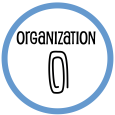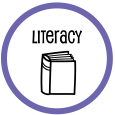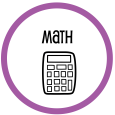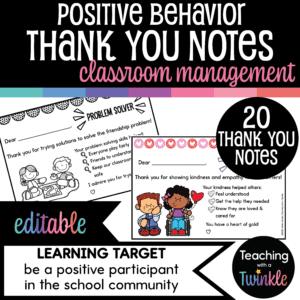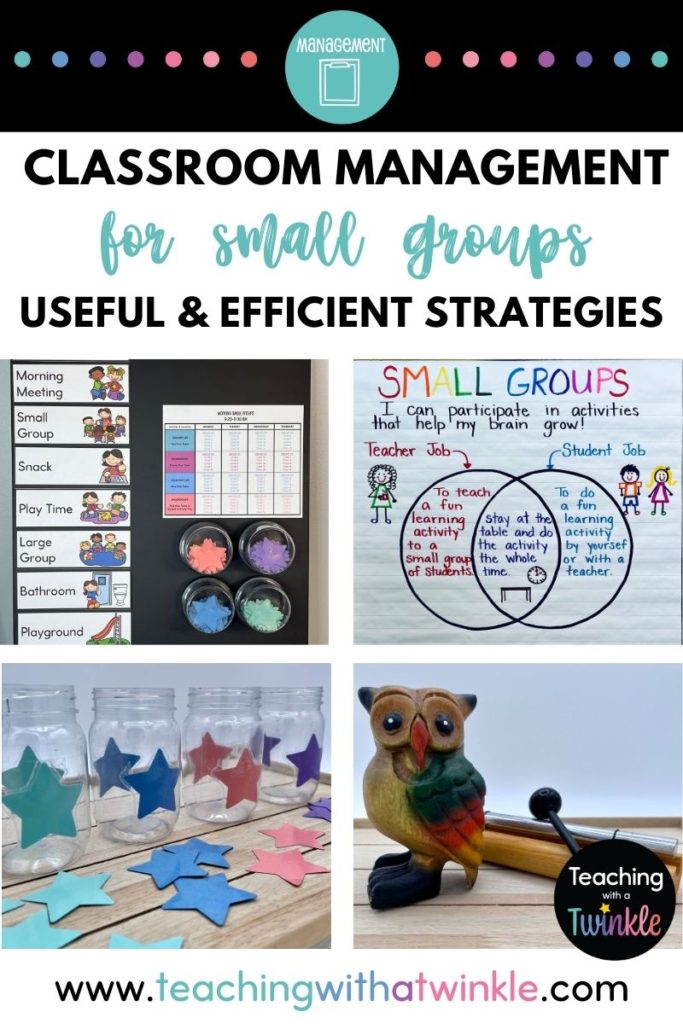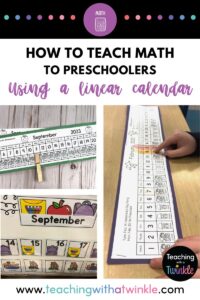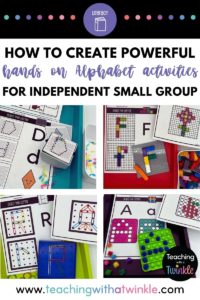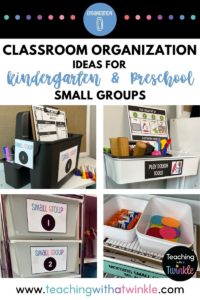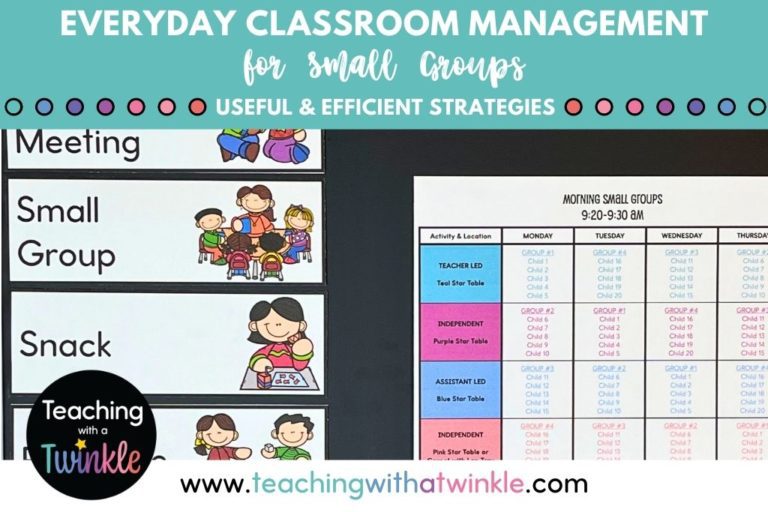
Classroom management for small groups might sound big and scary, but I am here to reassure you it’s not! So take my hand teacher friend, and crawl out from under your desk. I will stay by your side as you learn simple proactive management strategies that will transform your preschool or kindergarten small group routine. When students understand the what, why, and how of a routine, we are setting them up for independence and learning. And guess what’s even better? You will spend more time teaching and less time managing!
Speaking of spending more time teaching, I have a freebie to help you do exactly that! The 5 Steps to Setting Up Successful Small Groups in Your Preschool or Kindergarten Classroom walks you through getting your small group routine set up. Whether you are new to implementing small groups or are looking for a little renovation to your current small group routine, this resource is for you!
Before we do a pencil dive into small group management, I want to acknowledge the multitude of structures that a small group time can have. A small group routine can vary from classroom to classroom. Your small group routine or structure might look different than mine, and that is okay! The management strategies and techniques that I share can be used exactly as described or modified to best fit your classroom needs. With that said, here are what small groups look like in my pre-k classroom.
Small Group Structure in My Classroom
Small group time is a routine within my daily schedule. During small group time, students are divided into groups with approximately 5 or less children. All students are engaged in an activity at the same time, however, the activities that each group participates in are different. There are 2 types of activity structures during small group: teacher-led and independent activities. During teacher-led activities, the teacher instructs the students in their group. During independent activities, students participate in activities by themselves. I have 2 independent groups and 2 teacher-led groups (myself and my assistant) happening at the same time during my small group routine. Students complete 1 small group activity a day. By the end of the week, they have participated in all the small group activities.
I want to mention that when I taught kindergarten, reading workshop or daily five, was the equivalent to what I describe as “small group time.” The biggest differences were that the routine would last for an entire literacy block and the students would rotate through activities. My kindergarten students were divided into small groups and they rotated through activities with their small group. My table was the only “teacher-led” activity. The rest of the activities were independent. If this sounds like the structure of your “small group time,” I encourage you to keep reading! The management techniques that I describe can be utilized in your classroom!
To implement a successful small group routine, pre-planning proactive management strategies is a must! I find it helpful to think about proactive management strategies while I am in my classroom space. This helps me visualize what the routine will look like with students in my space.
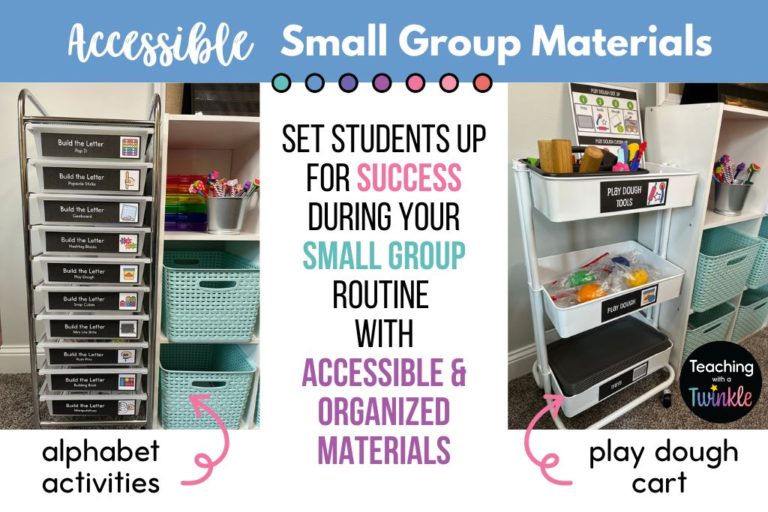
Planning The Environment
Reflecting on your classroom environment is the first step to implementing proactive management strategies! Use these small group guidelines to set up your classroom for optimal learning!
Choose the Location of Each Small Group
Where will each of your small groups take place within your classroom? In my classroom, I utilize 4 tables to designate where each small group takes place. You can use tables, the rug, specific areas of your classroom, etc. No matter where you choose to have your small groups gather, be sure that your students will be free of distractions (toys, hallways, etc.) and ensure that you can see what all students are doing from where you sit.
Stay within Close Proximity to Students
Think about which of the small group locations will be independent activities and which will be led by a teacher. In my classroom, I have my teacher-led small group area near an independent small group area. This helps me ensure that students are on task and if they need support, I am close by. Again, I also make sure that wherever I am sitting, I can see what everyone is doing at one time.
Label Each Small Group Area
Identify your small group areas with a visual. I have colored stars taped to the center of each table that is used for small groups. Each table is a different color. This helps my students identify which table they go to when they are dismissed for a small group. You could use different shapes, numbers, colors, animals, etc. If you are not able to use tape, you could hang a sign from the ceiling, above the small group areas. Identifying the small group area is important, because chances are, there will be a student who cannot figure out where to go.
Keep Materials Accessible
Think about any materials that students will need to use. I ensure that my independent groups are located near any materials they might need for their small group. For example, I utilize weekly letter activities for one of my independent small groups. These activities are in a 10 drawer cart. I also utilize a 3-tiered play dough cart for small group time. The location of these carts are right next to where the small group location is. If there are materials that your students will need access to on a regular basis, choose a space where they can access the materials without leaving their small group area.
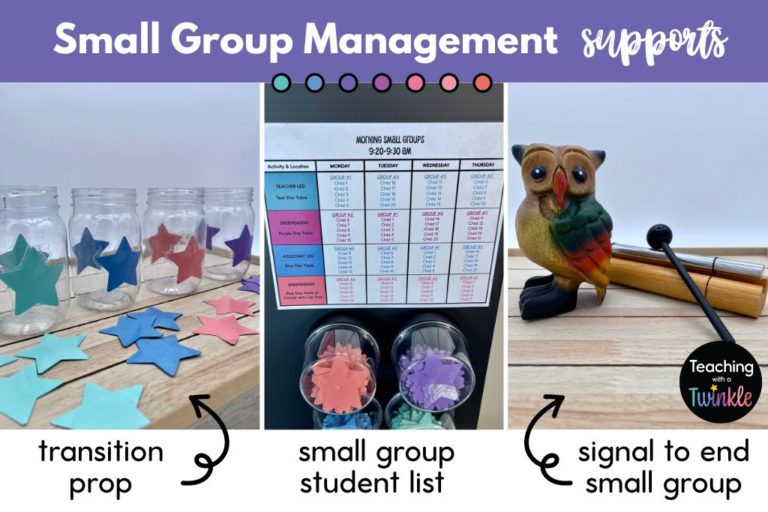
Supports during Small Group
Now that you know where your small groups will be located within your classroom, it is time to plan how students will get to their group, support while they are at their activity, and how you will get them to stop and clean up. The following classroom management strategies for early childhood are easy to implement.
Transition Props
Use a transition prop to help your students find the small group area that they are going to. In my classroom, students carry a paper star to the small group table they go to. The star gives the child a job to do while transitioning and serves as a reminder of where they are going. When dismissing students to their small group activity, I first announce the table and the activity and then say the names of the students that go to that table. “Today at the pink star table, these children will be working on letter H activities. Jack, Caroline, Isla, and Finn.” The students come up to me and I hand them a pink paper star. They carry it with them to the pink star table and place it in a container that is sitting on the table. You can use a colored piece of paper, a mini eraser, a plastic car, etc. Just be sure that it correlates to the label or sign that you have for the small group area.
For classrooms that rotate through multiple activities (similar to my kindergarten example above), I would not hand out a transition prop for each rotation. Instead, I suggest using a visual schedule that illustrates where the group goes first, second, third, etc. Each small group of students would need their own schedule that illustrates where they go and when. The visual schedule could be as simple as a piece of paper, a laminated bracelet with a velcro closure so it can be reused, a laminated card on a lanyard that they wear, make one child in the group the “captain” and they lead the group to the next rotation, etc. Just be sure that whatever visual “label” you have for each small group area/station/location, that it is the same visual you use on their schedule card.
Order of Dismissing Groups
The first group of students you should dismiss to small group, are the children participating in independent activities. This way, if those students have any questions, you are able to support them before you settle into your own small group. In my classroom, students who go to the pink star and purple star tables are always dismissed first. I have a classroom assistant that supports students getting started at independent activities, while I am dismissing the rest of the groups. The students in my group are last to go to their table. Since I am managing the small group transition, I do not want the students in my group sitting at the table waiting for me. Wait time = behaviors. Therefore, they are the last group to go to their table. This allows me to quickly start the visual timer and get to my table to start teaching.
Visual Timers
Once all students are at their small group activity, set a visual timer that all students and classroom staff can see. In my classroom, I have an interactive board, so I display a visual countdown timer that I embed into my google slides. If you do not have an interactive board, consider using a sand timer, timer on a tablet, or a visual timer that hangs on your wall. The timer is essential to helping myself and other classroom staff pace our small group lesson. The students utilize it to track how much time they have left. If you use a visual timer from the internet, I suggest the mantra, “boring is better.” There are timers with songs, sounds, lots of visual movement and timers that reveal a picture. I suggest staying away from those timers. The timer I use is black and white. Boring and perfect!
Signal to End Small Group Time
You will need a signal to identify that small group time is over. This could be a call and response, chant, song, chime, bell, whistle, doorbell, etc. In my classroom, I ring a chime or blow a whistle (that sounds like an owl). Once I blow the “owl whistle,” I immediately say, “Hands on top,” and the students respond, “everybody stop,” while simultaneously freezing and putting their hands on their head. I give directions on what to do next. It goes something like this, “It is time to put your small group activity away. Clean up, give your chair a hug, sit at the rug. Thank you for listening.” When students hear me say the magic words, “thank you for listening,” that is their cue to start moving again to complete their 3 jobs (clean up, push in their chair, sit at the carpet).
Transition to The Next Routine
Planning what happens immediately after your small group routine is essential. You want the transition to go as quickly as possible to avoid off task behaviors. Since some students clean up faster than others, consider a quick and easy transition activity that you can implement. This is a short and sweet activity that will allow a few extra moments for all the students to finish cleaning up, while engaging the students who are ready. In my classroom, I do a finger play (or two finger plays) while my assistant picks up her small group activity, my small group activity, and supports getting all students to the rug. If you do not have another staff member to help, consider playing a brain break movement song that your students are familiar with like the “freeze dance.” This gives them something to do (and get the wiggles out) while you quickly finish cleaning up or assist a student.
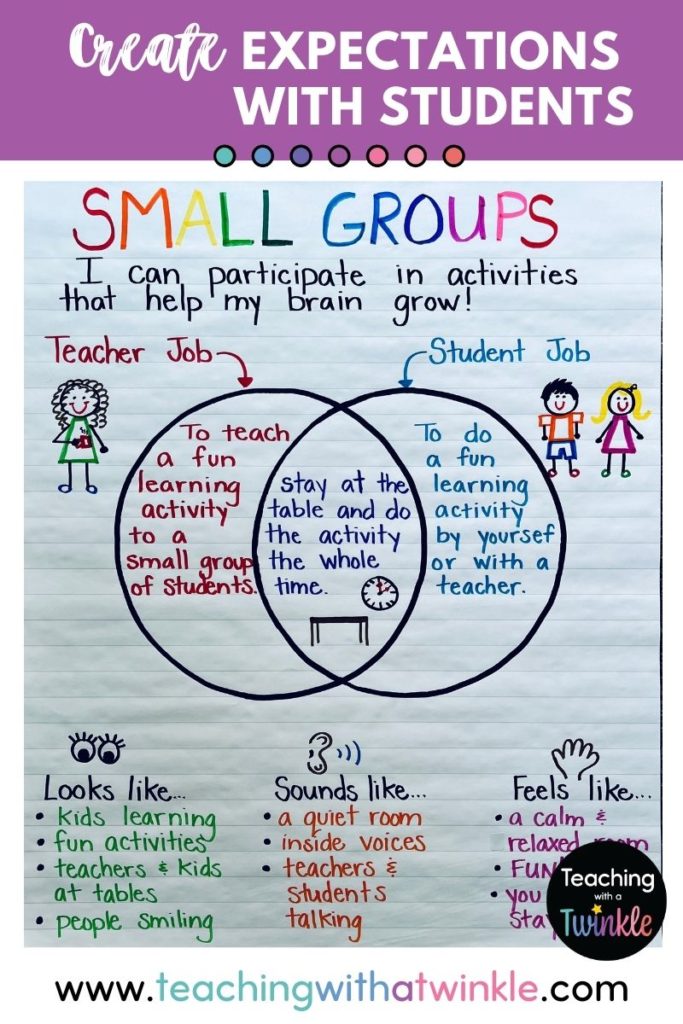
Implementing Small Groups
When you are ready to get your small group routine up and running, take a deep breath and go at your own pace. Be systematic and direct when implementing the following proactive behavior management strategies for small groups.
Set a Purpose
Explain to your students why small groups are important and what happens during small groups. This gives your students a purpose for participating in the routine. They will be more willing to do their best when they understand how it benefits them.
Create Expectations Together
Talk about what the classroom will look like, sound like, and feel like. Have your students imagine that they walked into the classroom during small group time. Ask them to describe what they see (looks like), hear (sounds like), and how it feels. Define what students are doing and what the teacher is doing. Make an anchor chart of their responses. When students are an active part of creating the expectations, they have a sense of ownership. If they helped MAKE the rules, they are more likely to follow them.
Practice, Practice, Practice
When it comes to classroom management for any routine, it is important to remember that it takes time to learn the correct way to do things. Provide many practice opportunities for students to demonstrate expected behaviors. Give yourself and your students grace. It can take multiple days to a few weeks for appropriate behaviors to become a part of a child’s muscle memory. Be cognizant of your students’ stamina. If they are not able to do small groups for the amount of time you expect them to, dial it back and slowly stretch the time longer as they demonstrate they can handle it. Taking the time to establish your routine with correct behaviors and procedures will save you tons of time throughout the year.
When practicing your small group routine, be sure to demonstrate exactly what you want your students to do. Say what you are doing as you are doing it. Next, ask a student to demonstrate the desired expectation. Have the other students comment on what they noticed the child did correctly. Then, have all students practice the expectation.
Short and purposeful practice sessions will help your students build their muscle memory. Focus on one part of the routine during a practice session. Have students practice finding their small group area, practice engaging with materials while a visual timer is going (shorten the time), or practice the clean up procedure.
Praise To Reinforce Behaviors
Reinforce positive behaviors by giving specific verbal praise, doing a class cheer, or handing out a sticker. It feels good to have our efforts recognized! Some other ways I use positive reinforcement is with a smelly spot, quiet critter, and a thank you note. A smelly spot is a scented chapstick that I rub on the students wrist for them to smell. A quiet critter is a small stuffed animal that will sit with or near the child/group of children doing expected behaviors. A thank you note is a printed note that students get to take home. It describes what the student did well and how their efforts help themselves and others in the classroom. Visit my TpT shop for more details on thank you notes.
Review to uphold expectations
At any time that your small group routine starts to fall apart, or get too relaxed, immediately review the expectations and give practice opportunities.
Take 2 minutes following small groups to review and practice the correct expectations. For example, let’s say that my students were putting activities away before I gave the signal to clean up. After small groups, I would review the expectations of when we put our activities away (when the visual timer is up and the teacher rings the chime). Next, I would have students go back to the location of their small group (yep, sit where they were) and give each group a bucket of toys (pattern blocks, etc.) that is easy to set out. I would set the visual timer for 2 minutes and have the class practice engaging until I gave the signal to clean up. Sometimes, I have the students continue to play after the timer is over (because we all know how life happens and you might need an extra minute to finish up.) Then, I would ring the chime and have the kiddos pick up, give their chair a hug, and join me on the rug. Praise those little learners for a job well done! The next day, quickly review the expectations that you practiced the day before.

READY FOR MORE SMALL GROUP STUFF?
Consistency is key to managing your small group routine! Be consistent with your procedures and with upholding student expectations. Your small group routine should be the SAME every day. The same time of day, time frame, location of groups, dismissal to groups, visual timer, end of group signal, and transition. Keeping the routine the same allows students to thrive in the procedures you have set up and build independence. So, in terms of your routine, “pick it and stick it”. Every. Single. Day. 🙂 In no time, all the work you invested in your classroom management for small groups will pay off!


